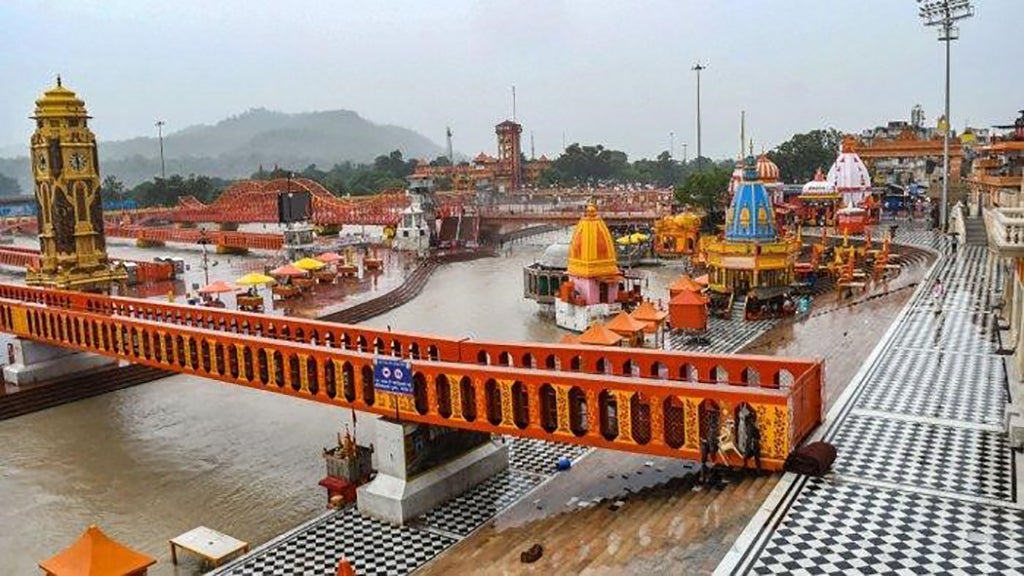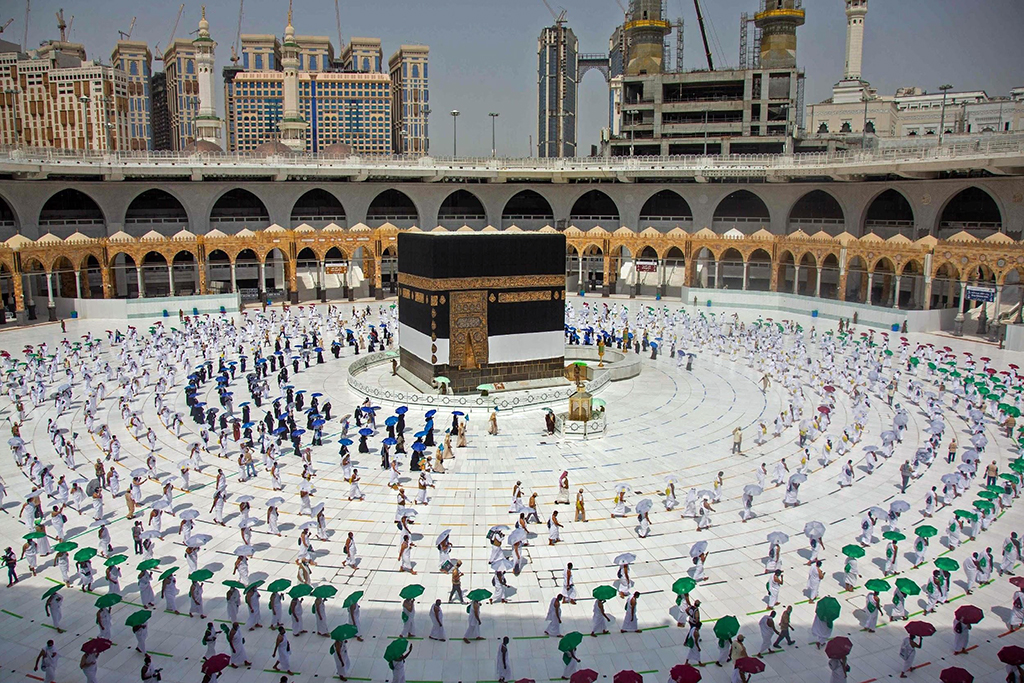Cleansing Afflictions in Sacred Places: Honouring the Ganga on Dashahara
contributed by Sohini Chakraborty, 15 July 2021
The Indian environmental landscape is marked by spaces attributed with sanctity as embodiments of divine essences. They are connected by flowing waters of rivers having healing capacities and function as therapeutic places.
The Ganges (or Ganga), Diana Eck (1999) suggests, is the symbol of archetypal sacred waters in Indic traditions. It is endowed with sacrality, spirituality, mystery and immense healing powers. Worshipped in the form of a goddess, she embodies the sacred - understood as pure (suchi, pavitra), auspicious (subha, mangala), bestowing good merit (punya). Her waters are regarded as amrit, the nectar of immortality. A dip into the sacred river has the potential to liberate the human from all mortal sins and leads one to the path of moksha, or liberation.
Fashioning Waters into Sacred Form
In Indic worldviews, times and spaces are not homogenous but are categorised according to their significance on scales of purity and pollution. 20 June 2021 marked the holy event of Ganga Dashahara, marking the descent of the Ganges on the Earth. It falls on the hottest months of the Hindu calendar, Jyeshtha or Ashadha, which corresponds to May and June. The tenth day from the Shukla Paksha (waxing phase or bright fortnight in the lunar calendar) is considered the auspicious time for taking a dip in the waters of the Ganges.
Mythology, geography and the ritual calendar are intertwined with notions of pollution, purity and sin in the Ganga Dashahara. It is not merely a discrete event but also a symbolic re-enactment of an elaborate myth of Gangavatarana, or the journey of Ganga across three worlds or lokas - Swarga (heaven), Prithvi (Earth) and Patala (hell). According to widely known myths, Ganga emerged in response to the appeal of King Bhagiratha to Lord Brahma to allow the sacred Ganges to fall from heaven to earth. King Bhagiratha had lost sixty thousands of his ancestors, burnt to ash by the fiery glance of Sage Kapila, and only through the spiritual significance of the sacred water of Ganges could the ancestors attain liberation.
While the Ganges plunged from heaven to earth, she was entangled in the ascetic dreadlocks of Lord Shiva in order to prevent destroying the earth with her enormous force. The river Ganges thereby came to be admired as Ganga, the Mother Goddess, in Indic traditions. Diving into the sacred waters of the Ganga during Dashahara in the month of Jyeshtha or Ashadha is significant since it “destroys the sins of ten lifetimes” according to Eck (1999: 260). Devotees drift across the river in boats with garlands to adorn the goddess and celebrate the holy day.

Figure 1: Devotees prepare to take a dip in the holy waters of the Ganga at Haridwar to celebrate the auspicious event of Ganga Avatarana. Source: Scroll.in
Diseases, Weathers and Localities juxtaposed
The Ganga Dashahara of Jyestha or Ashadha is synchronous with the onset of monsoon in the Indian sub-continent. While on the one hand it is the time for cleansing one’s sins, it is simultaneously a phase when the land is inundated by water whereby diseases and decay are flushed away. Ralph Nicholas (1981: 36) studied that “smallpox raged epidemically in the hot, dry months just before the onset of the monsoon in mid-June, and that it declined with the rainy season”.
Scientific rationale suggests that change of seasons lead to decrease of immunity in the human body. However, religious practices associated with such transitional phases are defined by elaborate legends and myths related to the worship of deities. Ritual healing by washing away of diseases along with flowing waters of the rains is associated with special food practices of consuming seasonal produce in fermented form as immunity boosters. Ritual calendars are marked by times for healing of the inner body as well as cleansing of outer surroundings.
The personification of Ganga as mother, the belief in her sacred powers in driving away malicious elements of nature lead devotees to worship not just water but its generative powers of giving birth, restoring life, conferring immortality. Stories about the sacrality of Ganga get intertwined with narratives about other indigenous deities. Often she is visualised in simultaneity with the serpent goddess Manasa in the premodern epic poem Manasamangal kavya. When Manasa’s request to sink the boats of a merchant was turned down by Ganga, Manasa threatened to poison the river. Fearful of losing her sanctity and predicting the perils large sections of population would have to face after the loss of their sources of water, Ganga agreed to help with Manasa’s request. Thereafter, the worship of Manasa has accompanied that of Ganga on the occasion of the Dashahara.
Coping with Contagion, Attaining Purity
It is a dilemma therefore, to think about dipping in holy waters and imagining congregation in the same landscape as a threat of contagion during the Covid-19 pandemic. This opens up two ways of imagining notions of purity and pollution - the traditional view highlighting the sacred connotations of the river and its ability of ritual healing the modern view with secular, physical and moral meanings of healing. (Chakrabarti: 2015) Those who take the holy dip often hold to the ritualistic view of the Ganga. For those following the strict regulations regarding social distancing rules, not taking the dip appears as ascribing to secular and mainstream medical notions of disease and disease prevention.
However, the two dimensions are not concretely distinct. Instead their boundaries remain fluid and often fuse into one another. With the outburst of the Coronavirus pandemic in India, the Disaster Management Act, 2005 and the Epidemic Diseases Act, 1897 have been invoked to ensure restrictive measures to curtail the spread of the disease. With reference to these Acts, religious institutions were instructed to carry out the festivities only in a symbolic manner, by bathing at homes using water from the Ganges.

Figure 2: An image of Haridwar, deserted after restrictions were introduced in the form of lockdown to contain the spread of Covid-19 through mass gatherings. Source:Press Trust of India Ltd. (PTI)
From Dichotomies to Junctures
David Kinsley (1988) suggests that the continuation of the well-being of a society is dependent on participation of members during tumultuous times, usually by means of religious rituals and traditions. Diseases therefore are often understood as “grace of God” or divine manifestation of Mother Goddesses in the ailing bodies of humans. The modern notion of diseases as causal and quantifiable deviation from the normal, functional state of the body is substituted by a nuanced understanding of illness. The cyclical conception of diseases in Hinduism interprets visitation of deities as the consequence of sin (paap), which can be undone by taking holy dip in the Ganga and offering prayers to her.
The religious responses to periodic visitations of catastrophes, diseases and crises foreground the spiritual palliative capacities of sacred waters which is why the self-purifying waters of the Ganga are regarded as capable of curing diseases. Therefore, mere sprinkling of its drops on the human body is considered equivalent to pilgrimage endowed with the power to undo physical and moral ailments, as purchase of Gangajal (Ganga water) for symbolic bathing at homes during the Covid-19 pandemic suggests.
The pervasive destruction caused by the waters due to adverse practices of immersion of diseased dead into the river does not disregard its spiritual significance. The waters that endanger are simultaneously hailed by the devotees as purifying, life-giving and bestower of health. The social and ritual life of these waters transcend the gap between definition of the Gangajal as a profane commodity and sacred ritual element. (Sen: 2019) Healing through Gangajal transcends the dichotomy of life and non-life, auspicious and adverse, healthy and diseased.
Cultural analysis of the river Ganga during the Covid 19 pandemic opens pathways to reconsider religious expositions of the disease as divine manifestation, naturalistic interpretations of diseased spaces derived from geographical imagination and biological explanations focussing on the etiology of the disorder. In its reinvented form during the pandemic, the Ganga embodies both traditional and modern values. Emerging meanings of the river as a sacred place problematize the concepts of modern and traditional as antithetical and suggest that conversations between these ideas require fresh understandings.
Works Cited
Chakrabarti, P. (2015). Purifying the River: Pollution and Purity of Water in Colonial Calcutta. Studies in History, 31(2), 178-205.
Darian, S. G. (1978). The Ganges in Myth and History. Honolulu: The University Press of Hawaii.
Eck, D. L. (1999). Banaras: City of Light. Columbia University Press.
Kinsley, D. (1988). Hindu Goddesses: Visions of the Divine Feminine in the Hindu Religious Tradition. Berkeley, Los Angeles & London: University of California Press.
Maity, P. K. (1966). Historical Studies in the Cult of Goddess Manasa. Calcutta: Punthi Pustak.
Nicholas, R. W. (1981). The Goddess Śītalā and Epidemic Smallpox in Bengal. The Journal of Asian Studies, 41(1), pp. 21-44.
Sen, S. (2019). Ganges: The Many Pasts of an Indian River. New Haven and London: Yale University Press.
Disclaimer: The views and opinions expressed in this article are those of the authors and do not necessarily reflect the position of the blog editorial team or the Asia Research Institute.
South Asia | Southeast Asia | East Asia | Other Places | Hinduism | Buddhism | Islam | Christianity | Other Religions
Other Interesting Topics
Gods Not Allowed: Restrictions and Repentance in International Kullu Dussehra 2020
The International Kullu Dussehra held in October 2020 was a controversial affair. In normal circumstances, this annual religious and cultural festival would attract a large number of devotees, traders, tourists and deities to the Dhalpur maidaan (ground) in Kullu, Himachal Pradesh, India. In 2020, however, the COVID-19 pandemic compelled the Kullu administration...
The Pandemic and its effect on the performance of Hajj Pilgrimage in Malaysia
One of the biggest milestones to be achieved in a Muslim life is the performance of hajj in Mecca, which is the fifth pillar of Islam. It is no surprise then, that it would be a news of a lifetime for Saroni Raop, 73, when he received a letter from the Tabung Haji earlier this year in February 2020...
Reactions of Touzi Buddhist Monastery in Tongcheng, Anhui, China to COVID-19
Touzi Monastery is located on Mt. Touzi 投子寺, Tongcheng, Anqing, Anhui Province, and about 3 km away from the downtown area of Tongcheng. The monastery was first built in the Eastern Han Dynasty (25–220 AD) and initially named “Auspicious Monastery” (Shengyin si 勝因寺). It is believed that during the Three Kingdoms period...




